Discover 15 hidden attractions, cool sights, and unusual things to do in Pompeii (Italy). Don't miss out on these must-see attractions: Amphitheater, House of the Faun, and Temple of Jupiter. Also, be sure to include Suburban Baths in your itinerary.
Below, you can find the list of the most amazing places you should visit in Pompeii (Campania).
Table of Contents
Amphitheater
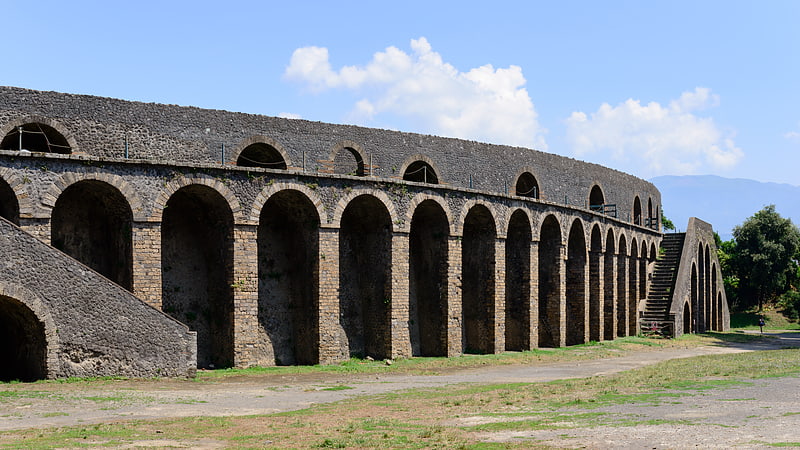
Also known as: Anfiteatro romano di Pompei
Ancient Roman arena for gladiator fights. The Amphitheatre of Pompeii is one of the oldest surviving Roman amphitheatres. It is located in the ancient Roman city of Pompeii, and was buried by the eruption of Vesuvius in 79 AD, that also buried the city of Pompeii and the neighbouring town of Herculaneum.
Six bodies were found during the excavations.[1]
Address: Piazza Anfiteatro, 80045 Pompei
House of the Faun
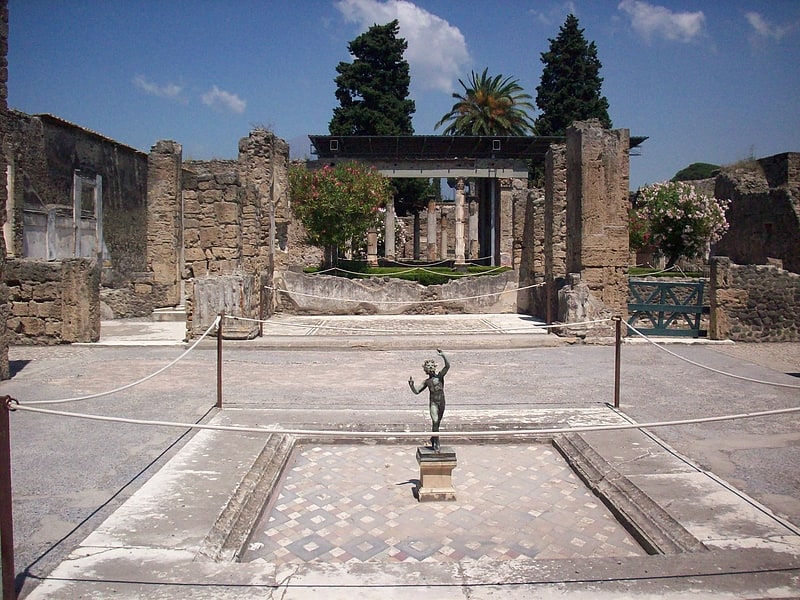
Also known as: Casa del Fauno
Pompeii's largest house . The House of the Faun, constructed in the 2nd century BCE during the Samnite period, was a grand Hellenistic palace that was framed by peristyle in Pompeii, Italy. The historical significance in this impressive estate is found in the many great pieces of art that were well preserved from the ash of the eruption of Mount Vesuvius. It is one of the most luxurious aristocratic houses from the Roman republic, and reflects this period better than most archaeological evidence found even in Rome itself.[2]
Address: Via Villa dei Misteri, 2, 80045 Pompei
Temple of Jupiter
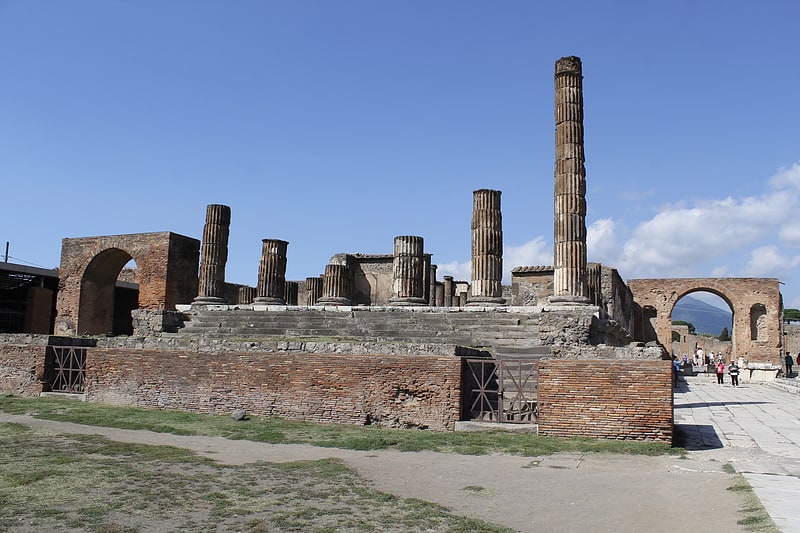
Also known as: Tempio di Giove
Temple in Italy. The Temple of Jupiter, Capitolium, or Temple of the Capitoline Triad, was a temple in Roman Pompeii, at the north end of its forum. Initially dedicated to Jupiter alone, it was built in the mid-2nd century BC at the same time as the temple of Apollo was being renovated - this was the area at which Roman influence over Pompeii increased and so Roman Jupiter superseded the Greek Apollo as the town's highest god. Jupiter was the ruler of the gods and the protector of Rome, where his temple was the center of Roman Religion and of the cult of state.
As the most important divinity in Ancient Rome, many temples were built to honor Jupiter or the entire Capitoline Triad (consisting of Jupiter, Juno, and Minerva) in towns newly conquered by the Romans. This held true for Pompeii, where the previously existing Temple of Jupiter was enlarged and Romanized upon conquest.
Pompeii was occupied by the Romans beginning in 310 BC. It maintained much of its autonomy, however, until the Italic Revolt against Rome at the beginning of the 1st century BC. In 89, the town was besieged by Sulla. Roman language, culture, and law would soon come to dominate the city.
The architecture of the town had been largely changed by the Greeks, but Roman rule would soon lead to alterations in this style. In contrast to the previous Samnite occupiers, the Romans very much believed in the importance of architecture in religious and civic life. Pompeii was transformed into a much more public and open place. Public buildings and spaces would come to dominate the city.
The temple structure was built in 150 BC to dominate the forum, and it became Pompeii's main temple after the Roman conquest. Pure Italic style characterized the capitolium structure, which sat atop a base measuring 121 x 56 x 10 feet. The interior of the temple contained the cella, which held the statues of Jupiter, Juno, and Minerva, and which only the priests were permitted to enter. There was a chamber below the main hall which was used to store sacrificial offerings and the treasury of the city.
In 62 A.D. an earthquake shook the city of Pompeii, destroying much of the Temple of Jupiter. After this, the much smaller Temple of Jupiter Meilichios became the main seat of worship to Jupiter and the Capitoline Triad. The original Temple of Jupiter was still awaiting restoration when Mount Vesuvius erupted in 79, burying the town of Pompeii in volcanic dust, ash, and pumice stones. The excavated temple can still be seen in Pompeii today. This was a place where people would come to pray to the god Jupiter which later on became the name of a planet.[3]
Suburban Baths
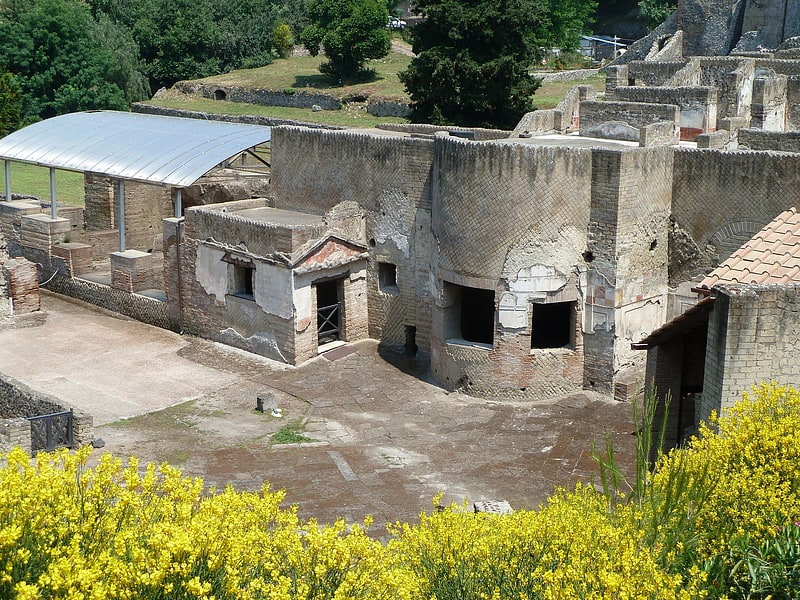
Also known as: Terme Suburbane
Archaeological site in Pompei, Italy. The Suburban Baths are a building in Pompeii, Italy, a town in the Italian region of Campania that was buried by the eruption of Mount Vesuvius in 79 AD, which consequently preserved it.
The Suburban Baths were publicly owned, as were also the Stabian, Forum, and Central baths in the city. They were built in the early empire, possibly under the Emperor Tiberius (14–37 AD), much later than the others and thus were built outside the city walls near the Porta Marina, one of the city gates. By this time, land was more easily available outside the city as the walls had lost their defensive role after the town became a Roman colony.
The baths also benefitted from the increased supply of running water after the connection of the city to the Aqua Augusta aqueduct in 30–20 BC.
The bathhouse was renovated after the earthquake of 62 AD, when a piscina calida, a heated swimming pool, was added to the north of the complex.
The baths were discovered in 1958, much later than the rest of the city, though a systematic excavation had to wait until 1985–1987.
Although publicly owned, these baths seem to have been reserved for a private clientele unlike the other public baths.
The building is notable for its surviving erotic wall paintings, the only set of such art found in a public Roman bath house.[4]
Address: Via Marina, 6, 80045 Pompei
Shrine of the Virgin of the Rosary of Pompei

Also known as: Santuario della Beata Vergine del Rosario di Pompei
Shrine in Pompei, Italy. The Pontifical Shrine of the Blessed Virgin of the Rosary of Pompei is a Roman Catholic cathedral, Marian pontifical shrine and minor basilica commissioned by Bartolo Longo, located in Pompei, Italy. It is the see of the Territorial Prelature of Pompei.[5]
Address: Via Piave, 6, 80045 Pompei
Temple of Isis
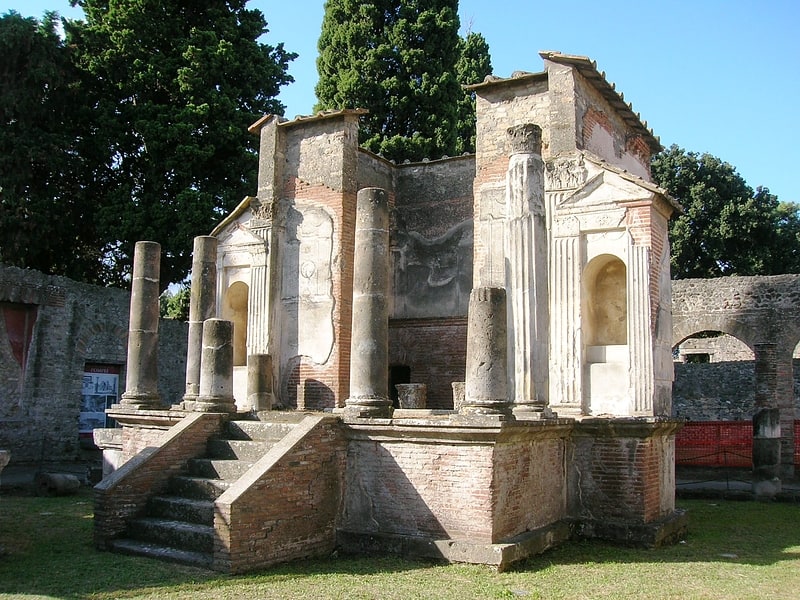
Also known as: Tempio di Iside
Building in Italy. The Temple of Isis is a Roman temple dedicated to the Egyptian goddess Isis. This small and almost intact temple was one of the first discoveries during the excavation of Pompeii in 1764. Its role as a Hellenized Egyptian temple in a Roman colony was fully confirmed with an inscription detailed by Francisco la Vega on July 20, 1765. Original paintings and sculptures can be seen at the Museo Archaeologico in Naples; the site itself remains on the Via del Tempio di Iside. In the aftermath of the temple's discovery many well-known artists and illustrators swarmed to the site.
The preserved Pompeian temple is actually the second structure; the original building built during the reign of Augustus was damaged in an earlier earthquake, in 62 AD. At the time of the 79 AD eruption of Vesuvius, the Iseum was the only temple to have been completely re-built; even the Capitolium had not been. Although the Iseum was wedged into a small and narrow space, it received significant foot traffic from theater-goers at the Large Theater, businessmen in the Triangular Forum, and others along the Stabian Gate.
Principal devotees of this temple are assumed to be women, freedmen, and slaves. Initiates of the Isis mystery cult worshipped a compassionate goddess who promised eventual salvation and a perpetual relationship throughout life and after death. The temple itself was reconstructed in honor of a 6-year-old boy named Numerius Popidius Celsinus by his freedman father, Numerius Popidius Ampliatus, and his mother Corelia Celsa, to allow the child to enter elite society. Many scenes from the temple are re-created in the dining rooms of Pompeians, however, indicating that many individuals visited this temple for political, economic, or social reasons.[6]
Villa of the Mysteries
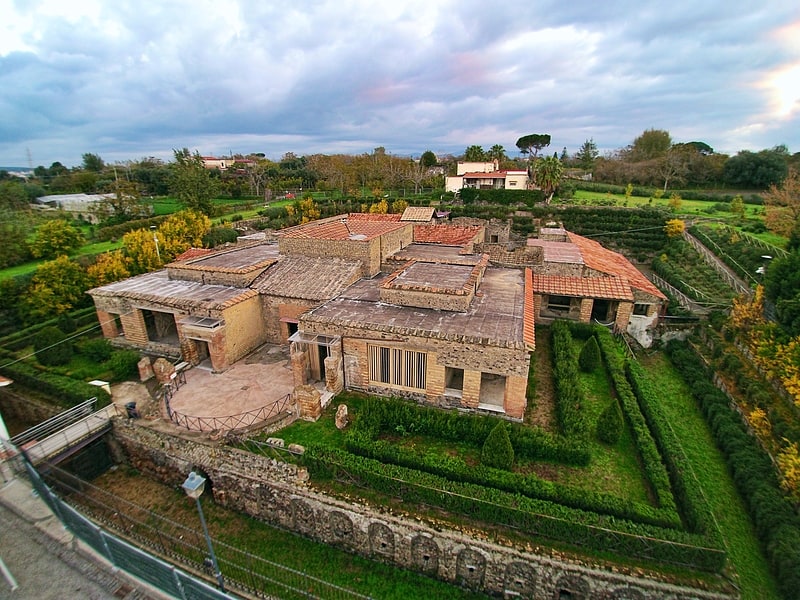
Also known as: Villa dei Misteri
Historical landmark in Pompei, Italy. The Villa of the Mysteries is a well-preserved suburban ancient Roman villa on the outskirts of Pompeii, southern Italy. It is famous for the series of exquisite frescos in one room, which are usually thought to show the initiation of a young woman into a Greco-Roman mystery cult. These are now among the best known of the relatively rare survivals of Ancient Roman painting from the 1st century BC.
Like the rest of the Roman city of Pompeii, the villa was buried in the eruption of Mount Vesuvius in 79 AD. It was excavated from 1909 onwards (long after much of the main city). It is now a popular part of tourist visits to Pompeii and forms part of the UNESCO World Heritage Site at Pompeii.[7]
Address: Via Villa Dei Misteri 2, 80045 Pompeii
Temple of Apollo
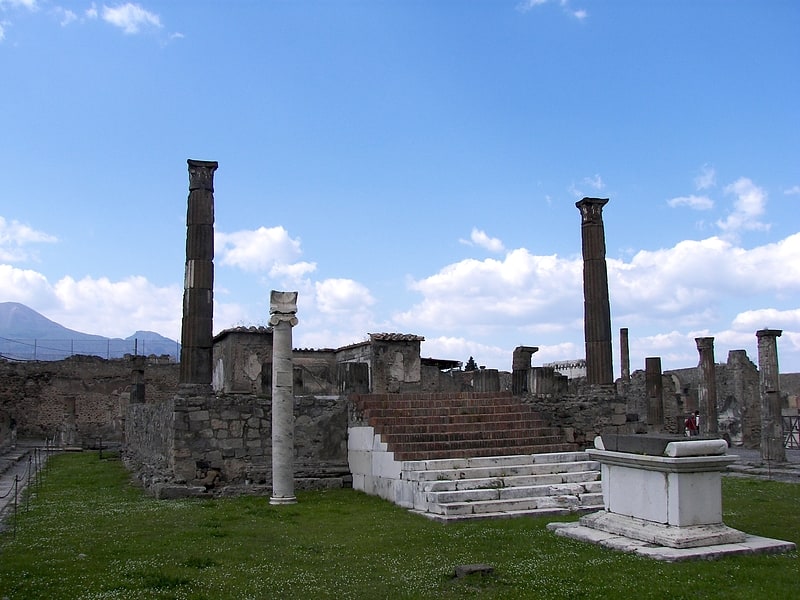
Also known as: Tempio di Apollo
Pompeii ruins of ancient Roman temples. The Temple of Apollo is a Roman temple built in 120 BC and dedicated to the Greek and Roman god Apollo in the ancient Roman town of Pompeii, southern Italy.
Located in the forum (market place) and facing the northern side of the town, it is the town's most important religious building and has ancient origins. The cult of Apollo, imported from Greece, was widespread in Campania, and from excavations in the temple's vicinity has been shown to have been present in Pompeii since the 6th century BC. The sanctuary's present appearance dates from its 2nd-century BC rebuild, and a further reconstruction to repair damage from the 62 earthquake, repairs which were left incomplete at the time of the eruption. The temple, in the center of a sacred enclosure, was surrounded on all four sides by a wide series of tuff columns from Nocera, originally grooved and with Ionic capitals, that were being replaced with stucco columns and Corinthian capitals painted in yellow, red and dark blue.
The elegant Doric architrave of metopes and triglyphs resting on the columns was transformed into a continuous frieze with griffins, festoons and foliage. Today, the remains of the temple front appear as they originally did, since almost all of this transformation in plaster has disappeared. Some statues of a deity have been recovered, facing the columns of the portico, and are now in the National Archeological Museum of Naples, though copies of two of them – one representing Apollo, the other a bust of Diana – have been placed where the originals were found.
The temple itself, a peripteros with 48 Ionic columns, was on a high podium and entered up an imposing set of steps, in a fusion of Greek and Italic architectural ideas. Unusually, the cella is sited further back with respect to the peristyle. In front of the steps may still be seen a white marble altar on a travertine base, with a Latin inscription giving the names of the quattuorviri who dedicated it. To side of the steps is an Ionic column that supported a sundial.
In the side of the perimeter wall of the Temple of Apollo, facing onto the town's forum, a niche is extracted containing the mensa ponderaria; the table with the town's official measures, to guarantee the citizen against fraudulent shopkeepers and merchandise.[8]
Lupanar

Brothel ruins on the Pompeii site. The Lupanar of Pompeii is the ruins of a brothel in the Ancient Roman city of Pompeii. It is of particular interest for the erotic paintings on its walls. Lupanar is Latin for "brothel". The Pompeii lupanar is also known as Lupanare Grande or the "Purpose-Built Brothel".[9]
House of the Prince of Naples
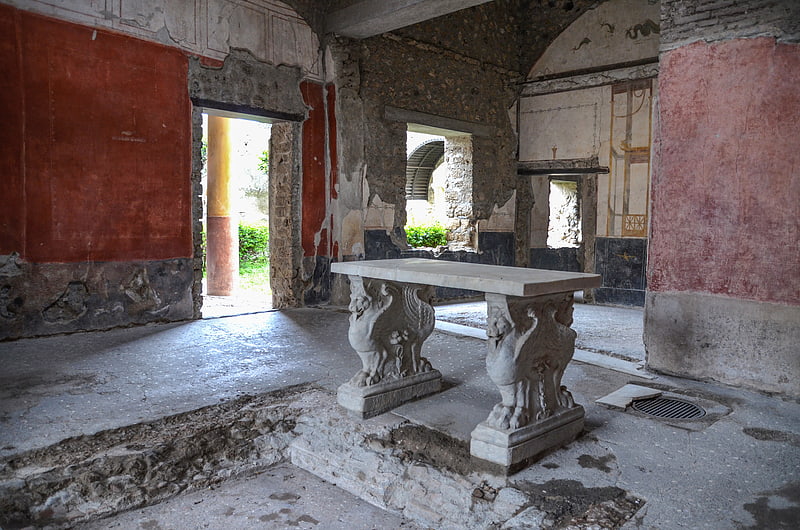
The House of the Prince of Naples is a Roman domus located in the ancient Roman city of Pompeii near Naples, Italy. The structure is so named because the Prince and Princess of Naples attended a ceremonial excavation of selected rooms there in 1898.
The house is painted throughout in the Pompeian Fourth Style and is valued because its decoration is all of a single style and single period, unlike many others that are often a mix of styles from different periods.
It is located in Regio VI, Insula XV of the city.[10]
Foreign influences on Pompeii
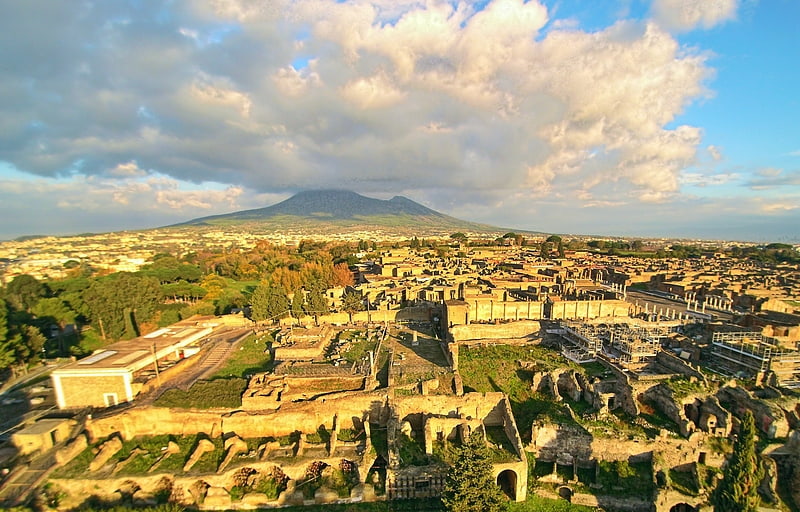
Several non-native societies had an influence on Ancient Pompeian culture. Historians’ interpretation of artefacts, preserved by the Eruption of Mount Vesuvius in 79, identify that such foreign influences came largely from Greek and Hellenistic cultures of the Eastern Mediterranean, including Egypt. Greek influences were transmitted to Pompeii via the Greek colonies in Magna Graecia, which were formed in the 8th century BC. Hellenistic influences originated from Roman commerce, and later conquest of Egypt from the 2nd century BC.
Specifically, these cultures contributed to the development of Pompeii’s art, architecture and religious spheres. For instance, Greek influences can be identified in the Alexander Mosaic, horse-shoe shaped theatres and Pompeii’s adoption of the Greek pantheon of gods. Examples of Egyptian influences can be found in the Nile Mosaic, garden art in the Villa of Julia Felix and the Cult of Isis.[11]
Villa of Diomedes
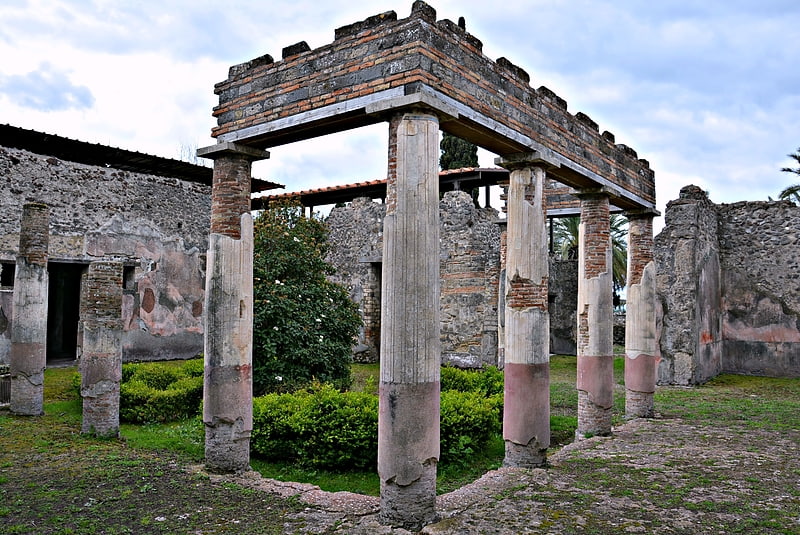
The Villa of Diomedes is an ancient Roman villa near Pompeii, Italy.
It is located outside the walls of Pompeii on the Via dei Sepolcri to the Gate of Herculaneum.
It was excavated from 1771 to 1774 by Francesco La Vega.
It was named after Marcus Arrius Diomedes, whose grave is opposite the entrance to the villa, though it is not clear that it was in fact his villa.[12]
Casa di Ottavio Quartione
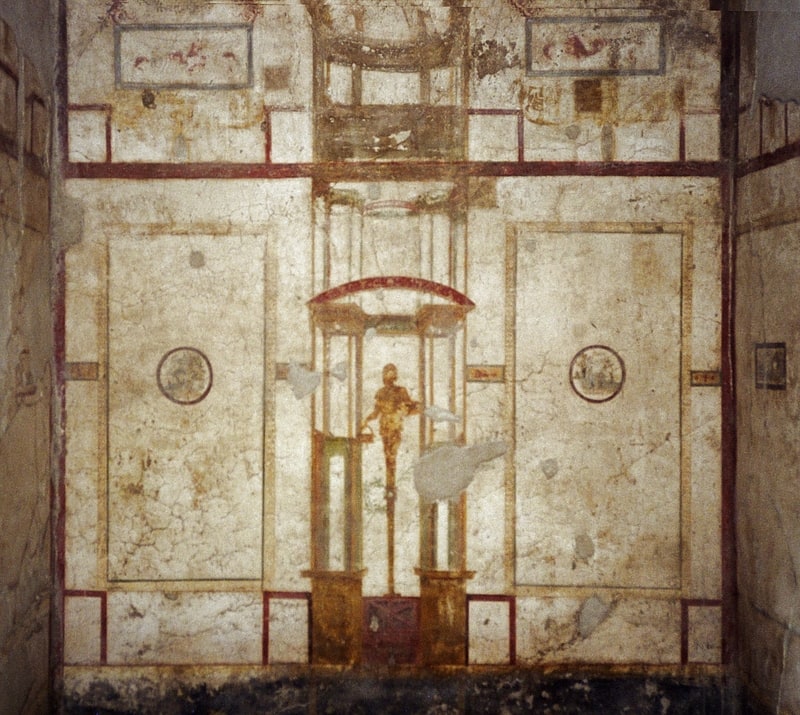
Historical landmark in Italy. The House of Loreius Tiburtinus is renowned for its meticulous and well-preserved artwork as well as its large gardens.
It is located in the Roman city of Pompeii and with the rest of Pompeii was preserved by the volcanic eruption of Mount Vesuvius in or after October 79 AD.[13]
Forum
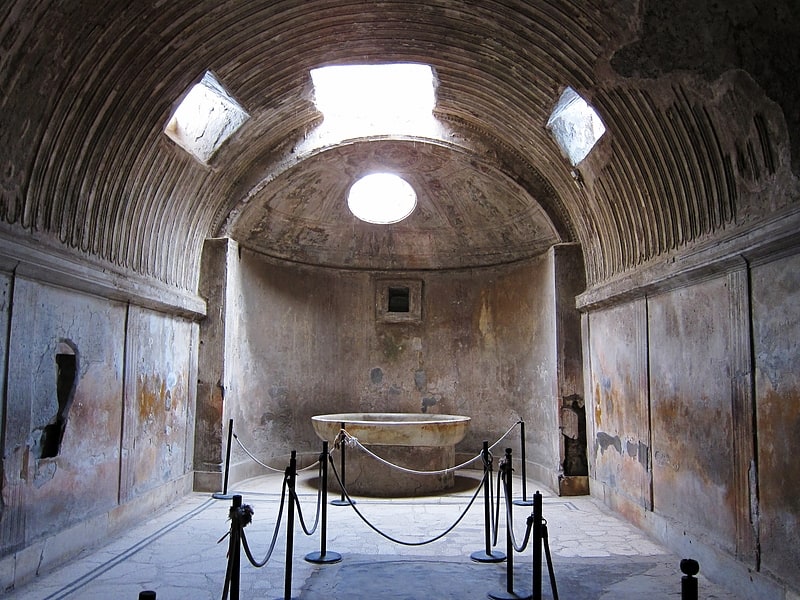
The Baths of the Forum, also called the Baths of Fortune, are a thermal complex from Roman times, buried by the eruption of Vesuvius in 79 and found as a result of archaeological excavations in ancient Pompeii: named for their proximity to the forum.
House of Sallust
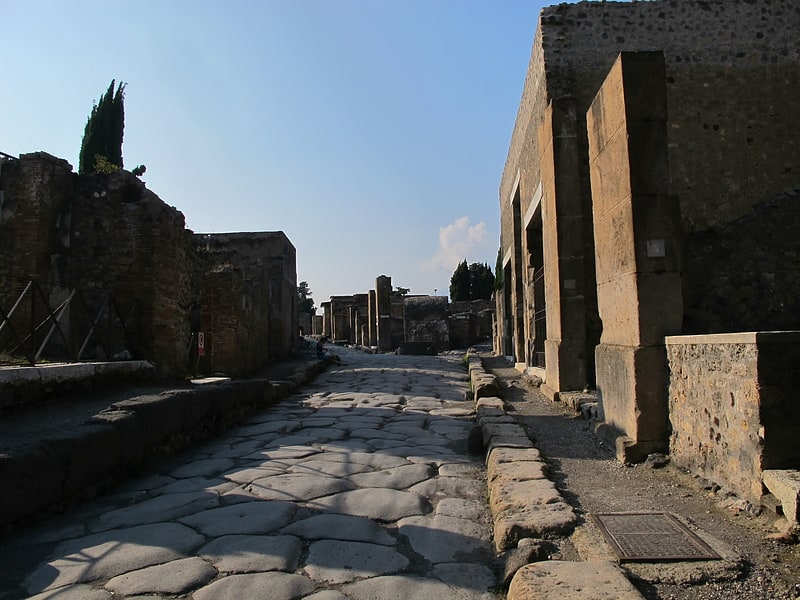
Also known as: Casa di Sallustio
Monument in Italy. The House of Sallust was an elite residence in the ancient Roman city of Pompeii and among the most sumptuous of the city.
The oldest parts of the house have been dated to the 4th century BCE, but the main expansions were built in the 2nd century BCE during the Roman period. The long history of this structure provides important evidence about the development of elite residences in Pompeii.
The house is located in Regio VI, Insula 2, 4 on the east side of the Via Consolare. It received its modern name from an election notice placed on the facade, recommending Gaius Sallustius for office. An alternative name is the House of A. Cossus Libanus, from a seal found in the ruins. The site was later damaged by a bomb in World War II, and was restored in 1970.[14]